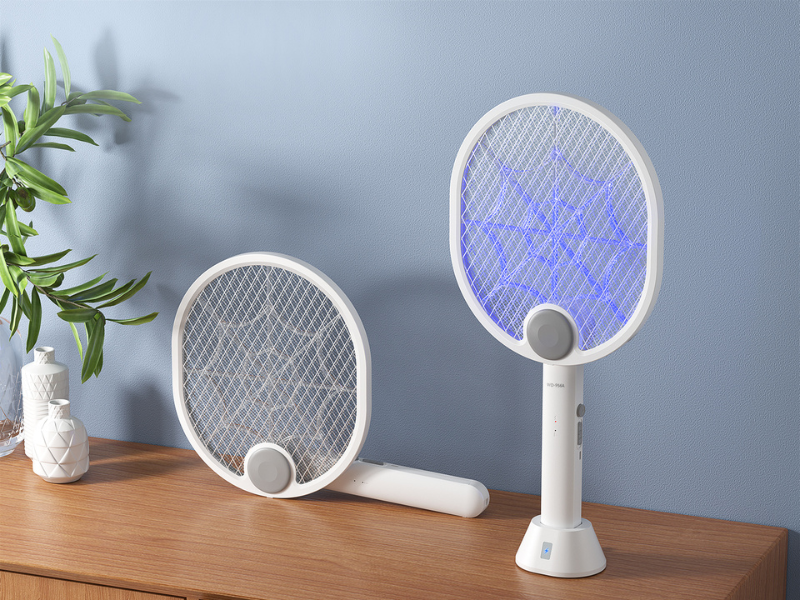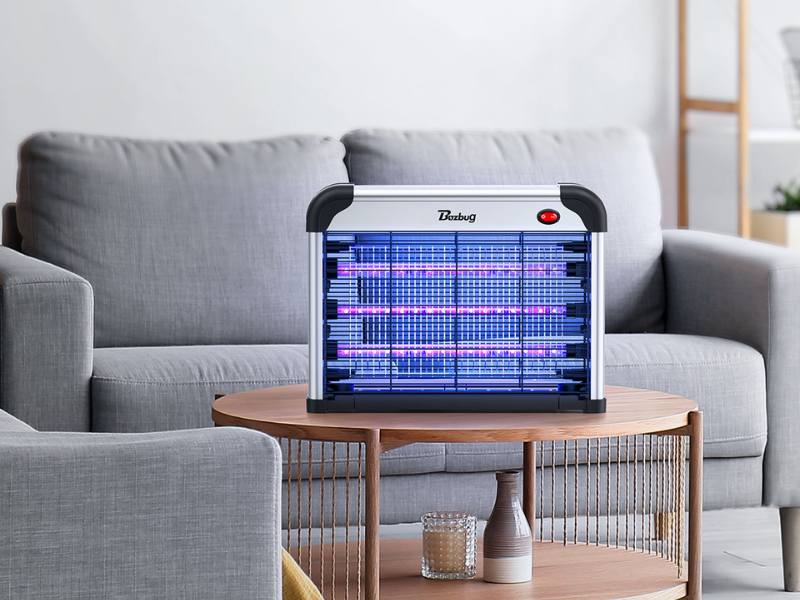Tired of pesky bugs? An electric fly swatter is a great solution. But with so many options, how do you choose the right one? Don’t worry—this article will explain 4 key factors to consider, helping you find the perfect fly swatter for your needs.
1. Indoors vs. Outdoors, Get the Best of Both Worlds
1.1 Indoor Use: Consider Surface-Contact Fly Swatters with Base
When dealing with indoor pests, efficiency and convenience are everything. A smart choice for indoor spaces is a fly swatter that can lie flush against flat surfaces like walls or tables, without leaving a gap. Since many insects like to rest on these surfaces, having a swatter that allows the racket face to make full contact with the wall greatly increases your chances of catching them. This design ensures that bugs have nowhere to escape when you press the swatter directly against the surface, making it perfect for zapping those sneaky insects that like to hide in corners or crawl along flat areas.
Additionally, consider a swatter with a base. This allows you to keep it upright and easily accessible, so when that mosquito suddenly appears in the room, you can grab it and zap it without having to rummage around. A surface-contact electric fly swatter with a base means you’ll always be ready to deal with bugs quickly and effectively while keeping your home tidy and organized.

1.2 Outdoor Use: Compact, Portable, and Built for Adventure
For outdoor use, portability and ease of use are essential. A compact bug zapper racket is lightweight, easy to carry, and perfect for outdoor adventures like camping or picnics.
Look for a mosquito swatter with a foldable handle for easy storage. It’s convenient to pack in your backpack and takes up little space. When you’re ready to use it, simply unfold, zap, and enjoy your bug-free surroundings.

2. Rechargeable or Battery-Powered? The Pros and Cons
The next big decision: Do you want a rechargeable or battery-powered swatter? Both have their advantages, so let’s break it down to help you decide.
2.1 Rechargeable Mosquito Swatters: Cost-Effective and Eco-Friendly
Rechargeable swatters are perfect for those who prioritize convenience and eco-friendliness. Simply plug them in when the battery runs low—no need to replace batteries constantly. Many models come with USB-C chargers, allowing you to charge them using power banks or phone chargers. Rechargeable swatters often feature battery indicators, so you’ll always know when it’s time to recharge.
However, if you're caught with a low battery, you’ll need to wait for it to recharge, which can be inconvenient.

2.2 Battery-Powered Electric Fly Swatters: Always Ready, Anytime, Anywhere
Battery-powered fly swatters are always ready to go as long as you have fresh batteries. No downtime, no waiting—just insert new batteries, and you’re back in business. This option is perfect for people who prefer a no-fuss solution. If you're heading outdoors for a camping trip or a picnic, packing an extra set of batteries ensures that your swatter can run for hours without the need for a charging station.
The downside? Over time, the cost of constantly replacing batteries can add up. Additionally, battery-powered options aren’t as environmentally friendly as rechargeable models, especially if you’re going through batteries frequently.
3. Design and Comfort: Finding a Swatter That Feels Right
3.1 Comfortable Grip: A Must for Long Swatting Sessions
Let’s start with the grip. You’ll be holding this swatter for a while, especially if you’re spending time outdoors, so it’s important that it feels comfortable in your hand. If your swatter is too bulky or uncomfortable, you’re not going to want to use it for long.
A comfortable grip also means better control. The easier it is to hold, the more precise your swings will be. And when you’re up against a fast-moving fly or sneaky mosquito, precision is everything. You don’t want to feel like you’re wielding a clunky bat when all you need is a nimble zapper!
3.2 Lightweight Design: Keep It Easy to Handle
Another factor to consider is the weight of your swatter. A good electric fly swatter should be lightweight enough that you can wield it for long periods without feeling like you’ve just done an arm workout. Heavy swatters can make your arm tired quickly, especially if you’re chasing flies around the house or zapping mosquitoes all evening at a backyard barbecue. But don’t go too light—if the swatter feels flimsy, it might not have the durability you need for long-term use. Balance is key!
4. Lighting and Safety: Essential Features for a Better Swatter
4.1 Built-In Lighting: See Clearly, Zap Confidently
Have you ever tried swatting a mosquito in a dimly lit room or while camping after the sun goes down? It’s tricky, to say the least. That’s where built-in LED lights on an electric fly swatter can make all the difference. These lights help you easily spot bugs in darker environments, giving you better visibility and making sure your swipes are accurate. Whether you’re indoors at night or outside on a camping trip, having a built-in light means you won’t have to rely on external light sources to get the job done.
Many modern swatters feature small, energy-efficient LED lights that illuminate the racket, making it easier to track and zap pests quickly. The light can also be helpful during those pesky evening hours when mosquitoes and gnats tend to swarm.
4.2 Safety Mechanisms: Protecting You and Your Loved Ones
Electric fly swatters are powerful tools, but safety should always come first. Whether you have kids, pets, or just want to protect yourself from accidental shocks, choosing a swatter with good safety features is crucial. Most high-quality swatters include protective outer grids that prevent fingers or paws from coming into contact with the electrified mesh. This means you can zap bugs confidently without worrying about accidental zaps to yourself or others.
Some models also come with safety switches that prevent the swatter from activating when it’s not in use. This can be especially useful in households with curious children who might accidentally press the button. Safety switches ensure the swatter is only active when you intend to use it, giving you peace of mind when it’s stored or charging.
Final, Product Recommendation: Buzbug’s WD956A Mosquito Swatter

For a versatile option that works in various settings, Buzbug's WD956A mosquito swatter is an excellent choice. It meets many of our selection criteria above.
- Flush-Contact Design: The swatter surface presses against flat surfaces to prevent bugs from escaping. Versions with a charging base offer quick access.
- Foldable Handle: Compact and portable, perfect for camping or outdoor activities.
- Rechargeable: Features a 1500mAh battery with Type-C charging and a battery indicator for easy monitoring.
- Lightweight and Ergonomic: Comfortable grip and easy to swing, perfect for extended use.
- Built-In LED Light: Zap bugs even in low-light conditions.
- Safety Features: Three-layer protective mesh and dual power switch prevent accidental shocks.
To learn more, please visit the WD956A product listing!


